(1)
Image from a 35mm film of Greek manuscript 1875 (Athens Natl. Bib. 149),
a praxapostolos. Shown is the opening page of I Corinthians 1. This
manuscript is dated circa A.D. 950. In
the image, Paul is holding an open scroll with the beginning of I Cor.
1 in OCS! The image appears to be part of the original manuscript, thus
this is a very old remnant of actual Old Slavic! Several other images
with OCS are seen in the manuscript as well. Above Paul are the OCS
abbreviations for "Saint Paul". Perhaps a reminder that the
Apostle Paul did preach to those in Illyricum as well. The words in
the scroll are a literal translation of the Greek words on the right,
even duplicating an unusual error/variant ("servant" instead
of "called"). [s.v. Romans 1:1]. The colored thumb and exquisit
image are via the Center for the Study of New Testament Manuscripts
(CSNTM) the entire MS is imaged there in all of its splender. www.CSNTM.org
The
"dots" around the painting of Paul and the other objects, are interesting,
they are typical of Irish or Insular artists! The gesture of Paul's hand is typical
of the Latin blessing form. The Eastern Byzantine form is usually with the third
finger and thumb touching, but artists also seem to present both forms indiscriminately. | |
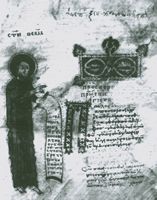
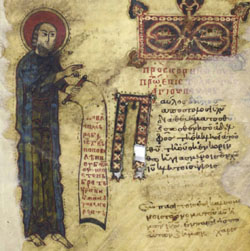
click to view |
(2)
Both images of the same leaf of the famous Ostromir (short) Lectionary, dated
A.D. 1057. Language is mixed east-Bulgarian and Russian. (per Metzger and Lunt). "It
was commissioned by Ostromir, the governor of Novgorod....In a lengthy codicil
on the last page of the book the scribe, Deacon Grigory, records that he worked
on it from 21 October 1056 to 12 May 1057. An inscription on the first page Evangelie
sofeiskoe aprakos states that Ostromir donated the manuscript to St Sophia's Cathedral
in Novgorod."
The
grayscale image is from a printed book, and has been slightly altered. Note, in
the headpiece, are floral designs and colors typical of Byzantine Greek scriptoriums.
One wonders if the scribe was also the illuminator? Perhaps the scribe was trained
in the South Slavic regions or on Mt. Athos? Text in this sample image is the
beginning of the Gospel of John. When compared to usual OCS texts of John, much
linguistic variety is seen. Lunt therefore does not see much text-critical value
in this MS, (I agree), nevertheless, it is interesting palaeographically and linguistically.
It is also the oldest dated Slavic manuscript. | | 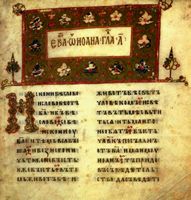
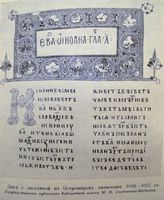
click
to view |
(3)
Dated A.D. 1073, contains writings by Theodoret. Artwork is Byzantine style. Some
of the animals are typical for early manuscripts from Calabria (s. Italy). Usually
Cherepnin's examples are in Russian libraries or museums. Image
is from a rather hard to find book, Russian
Palaeography by
Lev V. Cherepnin. Printed in Moscow,
1956. Attention
may be called to the glyph 3 which
is seen in several lines of the text, they may suggest a scribe whose vernacular
is not Russian. | | 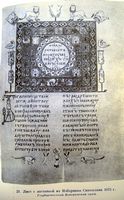
click to view |
| (4)
Again from Cherepnin, (s.v #3 above) is a MS dated at A.D. 1076. It is the first
in this list of examples to show a supralinear letter, in the next to last line. | | 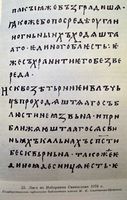
click to view |
(5)
More from Cherepnin (s.v. #3 above). Dated 1092, appears to be an aprakos lectionary.
I am unable to define the word inside the headpiece. mqase. | | 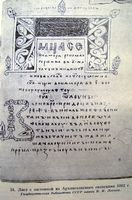
click to view |
(6)
Portion of a Croation Glagolitic Breviary, circa A.D. 1225. British Museum Add.
31951, folio 1. (from A History of Writing, Albertine Gaur). One
may note the squarish forms of the glyphs (typical Croatian) and the coloring
of numerous letters, similar to various Latin codices. Croatia was/is normally
under Latin sway. | | 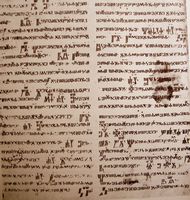
click
to view |
(7)
A nice enhanced image of the Bascanska inscription. Date circa A.D. 1080. (Enhanced
by Mr. Dykes). Per
Darko Zubrinic is the follwoing quote: "...found in the church of St. Lucy
near the town of Baska on the island of Krk. It contains about 400 Glagolitic
characters (dimensions of the tablet: 2x1 sq.m, 800 kg)... Glagolitic inscriptions
carved in stone (hundreds of them, the earliest known dating from the 11th century)
exist only on Croatian soil, and nowhere else." Zubrinic's
site is very informative, one ought to visit it! here is the URL: www.croatianhistory.net/et03.html
kkkor just www.croatianhistory.net
(URL current Sept. 11, 2010) In
the third line one reads: ZVONIMIR, THE CROATIAN KING. Thus this is a historical
monument. And a beautiful piece of work!! | | 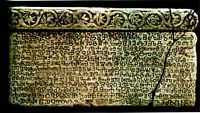
click
to view |
(8)
Sample from the famous Miroslav Gospel Lectionary (full aprakos). Dated circa
1180-1210. Serbian Church Slavonic or Serbian- form. Scribe, monk Pupil Gregory.
It seems to be derived from a Russian Old Slavonic redaction. (per Metzger and
Lunt). This
fragment was taken to Russia (stolen) by Archbishop Porfiry Uspensky while he
was at the Hilandar Monastery in circa 1846. The rest of the MS is in Belgrade.
It is the oldest known Serbian-form Biblical manuscript. It is said that it is
an extremely beautiful manuscript, lots of gold used in the illuminations! (my
sample certainly does not appear stunning, but it is a sample!)
| | 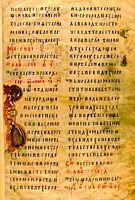
click
to view |
(9)
The Ochridanus Apostoli, date circa 12th century. Is of the Bulgarian-form of
OCS. Is now in the Lenin Library. Images
from the publication in 1907, titled: Bulgarski starini, volume iii. Article
(text) by Kulbakin. Available on-line as a PDF file. (search Archives or Google,
use search term "Starini" go to volume iii). [By the way, Google is
increasingly charging for certain popular oldie-but-goodie downloads, so get them
while you can! The actual scans of the transcribed text leave much to be desired.]. In
the first sample one may note (in the lower middle of the text) the ligatured
vi. | | 
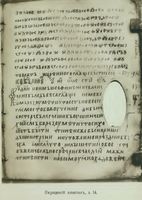
click
to view |
(10)
Borrowed from Tatiana Nikolova-Houston, the librarian at the University
Catholic Center in Austin, Texas.
This
image is of a very beautiful manuscript in Bulgaria. I found the colors
amazing! One may note the two forms of "Z" seen at the end
of line 2 of the text (z and
9).
Via
an email (Nov. 2015) from Tatiana!!
Tatiana
Four Gospels - Tetraevangelion
Slepche monastery - in Ohrid diocese. (village of Slepche, Macedonia)
60-70 years of the 16th century.
Residing in Bulgaria in the archive of the Orthodox church.
--------------------------------------------
galeandgary2000ATgmail.com
(change the AT to the @ symbol).
Thank you! (updated 2015)
| | 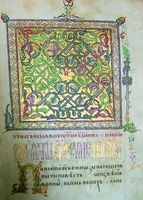
click
to view |
(11)
Two samples of Birch bark documents. They are actually everyday correspondences
which have been amazingly preserved in swampy areas primarily around Novgorod,
and in several other locations. The
upper sample is from Medieval Slavic Scripts vol.
1, by Charles Gribble. Slavic Pub. 1973. Gribble transcribed the sample into modern
Cyrillic. The lower sample comes from the University of Chicago, which has a must
see collection of images and Slavic artifacts: http://slavic.uchicago.edu/archived/bblphotos.shtml
(URL current Sept. 11, 2010) These
documents are dated circa A.D 1100-1400. So far hundreds have been excavated!
Often found about 15 feet down in the bogs, preserved because no oxygen could
get to them! | | 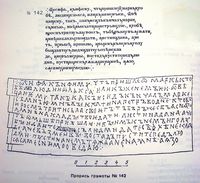

click
to view |
(12)
Another sample from Gribble (see #11). Dated circa XII - XIII. A charter for a
Russian Synodal Assembly. I
have not read Gribble's comments upon this sample, but typically in this era in
Russia, scribes who accomplish this level of quality are from the Balkans or the
monasteries of Mt. Athos. Recall that Russia, proper, was slow to produce accomplished
scribes and original manuscripts. The Russians typically imported educated clerics
from the Balkans, especially in the earliest centuries of their Christianity (circa
9th - 10th). Even in the 12th century most Russians could not read. The
ornamentation of this document betrays a Byzantine-trained scribe or illuminator. | | 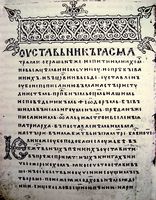
click
to view |
(13)
Two samples from the Austrian National Library, Vienna. Codex Slav. 7. Parchment.
Dated circa 1500. Language is the Bulgarian-form. Upper image shows the beginning
of I John. Lower image is a dedication page. Both images are from the beautiful
Taschen publication: The Most Beautiful Bibles (25th Anniversary Edition),
2008. 320 pages. A very well produced and beautiful volume, Amazon has the work
for 19 - 25 dollars, it has several hundred images in stunning color! Nice large
format. In
the upper sample, one may note the Byzantine style headpiece. It should be said
that the Slavic illuminators, though stemming from Byzantine sources, nevertheless,
produced outstanding miniatures and illuminations. When human figures are employed,
they add to the Byzantine types via an increased
sense of humanity, facial features are more realistic and less obtuse. One also
senses an increased warmth in the Slavic productions. (s.v. #19 below). In
the second line of text, note the word Bv which
suggests a good copy from its earlier exemplar. As in this period, the early 16th
century, many strong back "jer"s transform into the full "o"
vowel, [refer to Schmalstieg, §1.7081, page 20. An Introduction to Old
Church Slavonic, 2d ed..]. Thus in the later forms the word is often written
as Bo. The Old
Bulgarian and Serbian have Bv. The
Taschen edition has much more information on this manuscript. | | 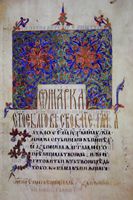
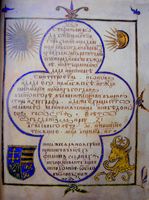
click
to view |
(14)
Apostolos, number 52, Natl. Library of Sofiya (Bulgaria). Dated A. D. 1362. Parchment.
From a catalogue of Slavic MSS in this library, by Professor B. Conevb, and published
by the library in 1910. Available as an Archives PDF file. www.archive.org An
interesting sample page (I wish I had more!). The page shows Acts 2:22-29. Some
of the orthography reflects archaic forms. For example in line 6, we see JgoWe
we note the retention of the earlier
"jer" J. The
word also reveals some of the literal closeness of the OCS to the Greek, as it
translates the Greek pronoun OV precisely, (in verse 24) and in initial position
as it is in the Greek (the object of "raised" is first in the sentence
as in the Greek) which draws emphasis to the word. | | 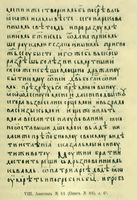
click to view |
(15)
Two images from scans of a 35mm film. Sinai Slavonic number 4. A praxapostolos.
Date, circa A.D 1350 - 1370. Serbian-form. Upper sample from beginning of I Corinthians.
Lower image Acts 5. No colophons, and no miniatures. Even
after the discovery in 1975, of more than 40 Slavic MSS at the Mt. Sinai monastery,
this remains the only Apostolos Slavic MS at Mt. Sinai. A film of it is available
from the Library of Congress. (on my main home / index page click "Acquiring
Manuscript Copies" and navigate to the LOC catalogues for ordering information). | | 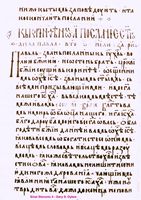
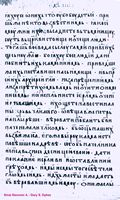
click
to view |
(16)
Triodion of St. Dionysious the Wonderworker. From Vologda Russia, 14th century.
At one time in the Schoyen collection. Apparently sold. (was known as MS 1751). Headpiece
is an excellent example of the union of Eastern artwork intermingled with some
Byzantine aspects. Note the formatting of the lines and borders, and the marginal
pricks for laying a straight-edge to draw the lines, these are on the outer margin,
it is bound on the right. Seems to be on parchment. Appears to have a note/colophon
at bottom of page. | | 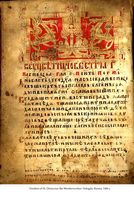
click
to view |
(17)
The famous Codex Zographensis, most likely the earliest MS on this webpage. Four
gospels, on parchment: 271 folia in OCS, plus 17 in Old Macedonian Church Slavonic
glagolitic script. Date circa late 10th. (per Metzger and Lunt). Image is of Mark
chapter 1. Written in Macedonia. It now lies in a Leningrad library. Lunt states: "Phonetically
it is nearest to the theoretical norms posited for the language of Cyril and Methodius,
but certain morphological forms (especially aorists) and some textual readings
seem to be rather younger." [Horace G. Lunt, Old Church Slavonic Grammar.
6th ed. 1974, page 6]. The
edition by Jagic is available as a download, but it is a poor copy, his transcription
of the first 6 verses of Mark 1 is shown (he conveniently converts to Cyrillic).
His linguistic observations are valuable, however. | | 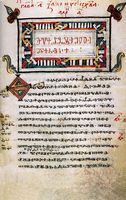
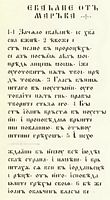
click
to view |
(18)
The Bitola inscription was made by order of the Bulgarian Tsar Ivan Vladislav
in 1015 or 1016 in connection with the fortification of the Bitola fortress. The
inscription was found in 1956 in Bitola, Macedonia and is stored at the Bitola
Historical Museum.
Text
of the inscription (translation from Old Bulgarian):
In
year 6253 (1015) since the creation of the world, this fortress, built and made
by Ivan, Tsar of Bulgaria, was renewed with the help and the prayers of Our Most
Holy Lady and through the intercession of her twelve supreme apostles. The fortress
was built as a haven and for the salvation of the lives of the Bulgarians. The
work on the fortress of Bitola commenced on the twentieth day of October and ended
on the...This Tsar was Bulgarian by birth, grandson of the pious Nikola and Ripsimia,
son of Aaron, who was brother of Samuil, Tsar of Bulgaria, the two who routed
the Greek army of Emperor Basil at Stipone where gold was taken...and this...
Tsar was defeated by Emperor Basil in 6522 (1014) since the creation of the world
in Klyutch (the Battle of Kleidion) and died at the end of the summer.
Borrowed
from:
http://en.wikipedia.org/wiki/Bitola_Inscription (URL current Sept. 11, 2010) | | 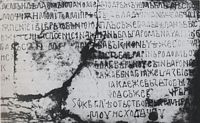
click
to view (enhanced by Mr. Dykes) |
| (19)
From somewhere in the bowels of my photographic collections, comes this icon/painting.
It is Slavic, possibly from the Monastery in Mt. Sinai. I include it so as to
impress you as to the beautiful artwork which the Slavic illuminators are capable
of. It is an icon of Christ enthroned, with the Virgin Mary and John the Baptist
(vid). Byzantine in style, but with added Slavic touches. (s.v. comments in #13
above). Note the gesture of Christ's right hand (His right), it is the usual Byzantine
blessing gesture. Observe Mary's expression. | | 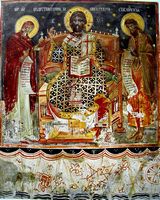
click
to view |
(20)
A sample from the Decani Monastery in Serbia, Epistle lectionary number 25. Date
A.D. 1350-1360. Parchment. One of many samples seen on the truly great website
of Serbian monasteries: http://slovo-aso.cl.bas.bg/index.html You
are encouraged to visit the website! The Decani monastery is located "...at
the foothill of the Prokletije Mountain, beside the river Bistrica, at the very
edge of the Metohija Valley which in its South-West part turns into a gorge."
(quotes are from the website). The monastery contains "About
160 manuscripts and 17 old printed books, which were part of the former monastery
library, have been preserved to the present time, making it a Serbian collection
second only to the one in the monastery of Hilandar. The manuscripts are written
on parchment and on paper and almost all of them are in medieval Serbian."
Curently (2011) the MSS have been temporarily moved and unavailable, to a secure
location. The text seen in the sample is Acts 1:1-3.
| | 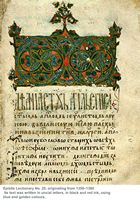
click
to view |
(21)
Sample from the Smolenskoi Psalter. Dated A.D. 1395. Also from Cherepnin (s.v.
#3, above). The
miniatures struck me as interesting. Each of the four creatures is labeled. The
upper right is Greece, below it the Antichrist. The bear is labeled as Babylon
(which is typically Medio-Persia in the Scriptures), and the upper left (a lion)
is labeled Rome. In Daniel, the lion is Babylon. It is interesting that the Antichrist
is not connected with any nation in this sample. | | 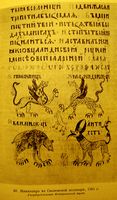
click
to view |
(22)
From Jernej Kopitar's collection from (or in) the National and University library
in Ljubljana. Kopitarevo bosansko evandelje. Parchment. Date, circa XIVth century,
collection number (Kop 024). The
headpiece illustrates some union of Byzantine and Eastern elements. Note that
the green seems to be a penciled type of application, or chalk, though it could
be a brush. Text is Matthew 1:1-3. This is the first leaf of the manuscript. Apparently
the whole manuscript can be viewed on-line at: http://digital.nb.rs/eng/browse.php?collection=ru-kop&order=xgod&page=30
(copy and paste this URL, it is all one line) URL current Sept. 11, 2010. This
is one of 34 digital copies within Jernej Kopitar's collection of Slavic manuscripts.
Many of which can be viewed and printed PAGE BY PAGE, at the above site! Saving
the images in digital format is a challenge, but the printing really works, the
MSS are viewed in a Flash/Real Audio plug-in. Worth a visit!! Another
site which also has some good, mostly Serbian-form manuscript samples, is: http://bibliodyssey.blogspot.com/2009/05/cyrillic-manuscripts.html
(URL current Sept. 11, 2010) A
site also worth a visit.
| | 
click
to view |
(23)
Both samples from a Serbian Psalter. Date circa XVth. Extracted
from a nice downloadable copy (scanned by Microsoft, which is viel besser als
Google). The publication concerns the miniatures in this Serbian Psalter, located
in the State Library in Munich. Cod. Slav. 4. The book is: Die
Miniaturen des Serbischen Psalters. circa
1904. By Josef Strzygowski. About 360 pages with numerous grayscale images. A
very good work discussing (with introduction by V. Jagic) ornamentations, styles,
initial letters, and Byzantine connections. Though in German, it is still one
of the best discussions upon Serbain (South Slavic) miniatures in MSS!! Available
from: www.archive.org
jj(A quick search word
would be Serbischen, or, Psalter). From
Jagic's description of the MS: "Der
jetzt in der königlichen Bibliothek zu München aufbewahrte serbische
Psalter mit Illustrationen, Cod. slav. 4, ist ein auf Papier geschriebener Kodex
serbischer Provenienz, spätestens aus dem Anfang oder der ersten Hälfte
des 15 Jahrhunderts." Note
the tear-drop shaped shields in the lower image. These are Byzantine style shields. | | 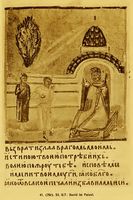
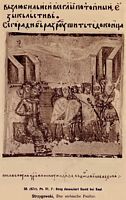
click
to view |
(24)
From same website as #7 above comes this quote as concerns this Croatian Glagolitic
MS:
"Probably the most interesting Glagolitic book is a liturgical book called
Missal of Hrvoje, written in 1404 by ...Butko. It has 94 beautiful illuminations,
380 colourful initials (some of them in gold), and many more small initials. Some
initials contain architectural elements of the city of Split. The book has been
kept in the Library of the Turkish sultans (Topkapi Saray) in Constantinople since
the 16th century. Once bound in precious covers (with gold and precisous stones),
from 19th century Hrvoje's Missal is in leather binding. It is written in two
columns on 488 pp (22.5x31 cm), and contains also some music notation." This
image shows some gold used in the ornamentation. Certainly one of the most beautiful
of manuscripts! The image is not from the website from which the quote comes.
I no longer recall where I got the image. | | 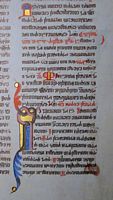
click
to view |
(25)
Sample image from the Schoyen collection. Bible, Menologian and Synaxarion (all
in one?) from Moldavia. Date circa A.D. 1450. Schoyen number 1750. Quote from
the Schoyen website: "MS
in Church Slavonic on paper, Monastery of Neamtu, Moldavia, ca. 1450, 266 ff.
(-6), 32x22 cm, 2 columns, (26x15 cm), 22-26 lines in a elegant Cyrillic half-uncial,
by Gabriel Uric of Neamtu." "[A]
Colophon by the scribe Gabriel Uric of the Monastery of Neamtu, who is known from
the colophons of MSS between 1424 and 1447. He was the initiator of a school of
calligraphy, manuscript illumination, orthography and literature which copied
Middle Bulgarian versions of Church Slavonic literature. These manuscripts
maintained the continuity of Bulgarian literature after the Turkish suppression
of the Bulgarian and Serbian states." | | 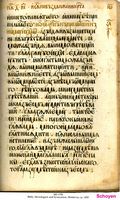
click
to view |
(26)
We cannot leave without a sample from the British Library, ADD. MS 39627. The
Gospels of Tsar Ivan Alexander. Date, 1355 - 1356. It was acquired by the Englishman
Robert Curzon, from the monastery of St. Paul on Mt. Athos. It was written in
Bulgaria before the fall of Bulgaria to the Ottoman Turks. It is a beautiful manuscript,
it contains 367 miniatures! In
this sample image, at bottom is portraits of Alexander (left) and Saint Mark (right).
The text is Mark 16:18-20. It can be tentatively identified as Bulgarian-form
OCS by its archaisms, for example retention of the nasal - 1
which later becomes the Serbian and
Russian U or u the
retention of the nasal is seen twice in line one of the sample. | | 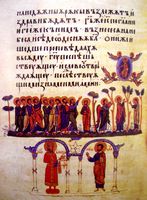
click
to view |
(27)
From the University Library in Prague comes this sample. Sample is part of 2 fragments
of a Glagolitic MS. Date circa XIth. in the middle of this sample is an indicated
(red) quote, not from the Scriptures. Apparently
the fragments (on parchment) were found tucked into a Latin praxapostolos MS.
I am unable to identify the text, but it does mention "Adam", and is
not part of the Bible. The image comes from a scanned book: GLAGOLITISCHE
FRAGMENTE
Dr. KARL ADOLPH CONSTANTIN HOFLER,
UND
Dr. PAUL JOSEPH
SAFARIK,
Prague. 1857. They
do a good job of evaluating the fragments. They also transcribe the MS into modern
Glagolitic print, as well as Cyrillic. Text is in German. I found the book at
www.archive.org - I believe I used the search term: Safarik or Glagolitische.
(p.s. - Prague and Sofiya and Iceland, are places I would really like to visit,
but I am very happy being heaven bound. And you?). | | 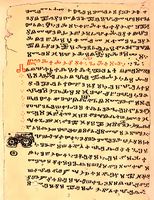
 transcription of above
transcription of above
|
(28)
The Four Gospels. Second half of 13th cent. Serbian-form, on parchment. Spelling
is typical for manuscripts of Serbian origin. Information below is mixed quotes
from the website: http://www.nlr.ru/eng/exib/Gospel/slav/index.html
(URL current Sept. 11, 2010)
The codex survives only in small fragments.
In addition to 6 leaves from the holdings of National Library of Russia, another
2 leaves from this book are known - they are kept in the Russian State Library.
The manuscript characterizes the provincial Slavic handwritten tradition. The
Gospel was copied onto poorly prepared dark and rough parchment. A typical Serbian
uncial script creates an impression of some carelessness. Alexander Hilferding
found the Gospel in 1857, while serving as a consul of Russia in Serbia. The place
of discovery is unknown.
In 1868 the manuscript came into the Imperial Public
Library along with the Alexander Hilferding's collection. [end partial quotes] Note
the interesting zoomorphic enlarged initial, often seen in S. Italian or Calabrian
Greek manuscripts of the 10th - 13th centuries. The text is from Matthew 23:38
- 24:5. NOTE:
In the above "partial quotes" - the quotes are from a Russian site,
they seem to slight the debt their nation has to the "south Slavs" for
the introduction of Christianity and education into Russia. The webmaster refers
to this manuscript as crude and "provincial" yet in Russia in the mid-thirteenth
century most folks could not read, and very very few souls could produce a manuscript
equal to 1/2 of the quality of this one! (unless they hired a Serbian, Bulgarian,
Croatian or Macedonian, which is how number 16 above, was probably created). G.S.D.
| | 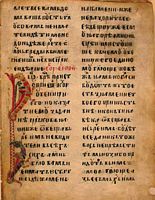
click
to view |
 CLICK TO
RETURN TO MAIN SLAVIC PAGE
CLICK TO
RETURN TO MAIN SLAVIC PAGE
 CLICK TO
JUMP TO MAIN / INDEX PAGE
CLICK TO
JUMP TO MAIN / INDEX PAGE
| | |

































